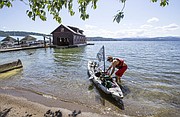What lurks in the lake
Jordan Smith knows lake health dictates the quality of the fishery he relies on for his livelihood.
Smith, who operates Fins and Feathers Tackle Shop and Guide Service in Coeur d’Alene, has seen slumps and spikes in Lake Coeur d’Alene’s fishery over the past three decades.
But, he said, the fluctuations in the fishery had little to do with water quality.
“I’ve never seen it as an active issue of fishing quality,” Smith said.
That’s because Lake Coeur d’Alene’s water quality is mostly good.
And thanks to a management plan overseen by the state and Coeur d’Alene Tribe — which manages the southern end of the lake — what happens in the lake doesn’t stay in the lake.
In 2009, The Coeur d’Alene Lake Management Plan divided the lake into several units that were monitored for heavy metals, organics and dissolved oxygen levels, all indicators of lake health.
The plan also gave stakeholders, such as lakefront property owners and surrounding communities, a roadmap to help them understand how their activities affect lake quality.
More recently, as part of the plan, the state and Tribe have released a report of water quality trends.
An update of the plan is among topics set for discussion today at the Coeur d’Alene City Council’s 6 p.m. meeting.
Among trends being watched by scientists from the Tribe and state Department of Environmental Quality are an uptick in productivity, which affects dissolved oxygen levels in the lake, as well as increased levels of dissolved lead in parts of Lake Coeur d’Alene.
Increased lead levels have been found below 90 feet in the northern lake, which is monitored by the Tubbs Hill monitoring site, but scientists who deal with seasonal and annual fluctuations are not sure what is causing the trend.
“We’re still trying to get a handle on how much is coming in, how much is settling out and how much is flowing out the Spokane River,” Jamie Brunnell of DEQ said.
Laura Laumatia of the Coeur d’Alene Tribe said lead levels, although on the radar of scientists, are less of a concern for the time being than levels of dissolved oxygen. When a lake becomes more productive, it produces more vegetation and animal life, which requires oxygen to decompose. When oxygen becomes depleted, heavy metals in the lake bottom — part of the area’s mining legacy — become solvent and are released into the water table.
“Decomposition and decreased oxygen affects the chemistry at the bottom of lake,” Laumatia said.
Because it is considered a low-productivity mountain lake, maintaining its natural balance as much as is feasible is paramount.
When it was introduced as a way to circumvent federal management — the EPA had threatened to take over management to deal with the 75 million tons of mining contaminants bound to the sediments at the lake’s bottom — the Lake Coeur d’Alene plan put management in the hands of local entities, none of which were given regulatory powers.
The plan encourages stakeholders to follow best practices, which is fine with Kirk Chaffin of Coeur d’Alene.
Relaxing at the water’s edge Monday at Boothe Park, Chaffin said lake management is a priority for him, to a point.
“I would hate to see it go like California where there are so many provisions and rules and regulations,” Chaffin said. “I want to keep it clean, and anything to keep it that way I would support, but I don’t want it to affect how we recreate on the lake.”



